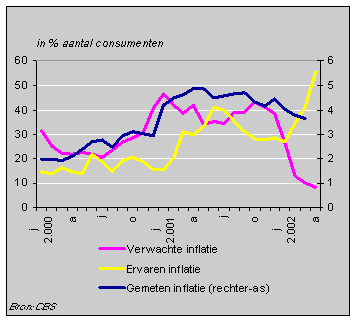Inflation feels higher

IInflation is determined on the basis of the development in prices of a fixed package of goods and services. Rising inflation usually leads to more and more consumers thinking that prices have gone up strongly. When inflation decreases the number of consumers complaining that prices have risen strongly also falls. This was very noticeable in 2000 and 2001.
Inflation measured, perceived and expected

Inflation falling, but consumers think differently
At the beginning of 2002, however, the perception of inflation fell out of step. The number of consumers who think that prices have risen strongly recently is increasing, while actually measured inflation is falling, from 4.4 percent in December last year to 3.6 percent in March.
One reason for the difference between actual and perceived inflation is the strong price rises for food and for eating and drinking out. These price increases are extra noticeable because consumers are confronted with them weekly and in some cases even daily. The relatively moderate development in prices of items like cookers and fridges is far less obvious.
The lower inflation in recent months is caused by moderate increases in prices of rent and energy.
Perceived inflation and food prices

Consumers expect inflation to fall
For the next twelve months consumers expect inflation to decrease. The percentage of consumers who expect prices to rise strongly has been falling since January 2002. As consumers are usually influenced by the current development of inflation when voicing an expectation, their expectations are not a good predictor of future price developments. However, their expectations do influence their decisions on whether to spend or to save. For example, many consumers purchased extra items in December 2000, in anticipation of the VAT increase introduced on 1 January 2001.
Gert Buiten and Jan Walschots